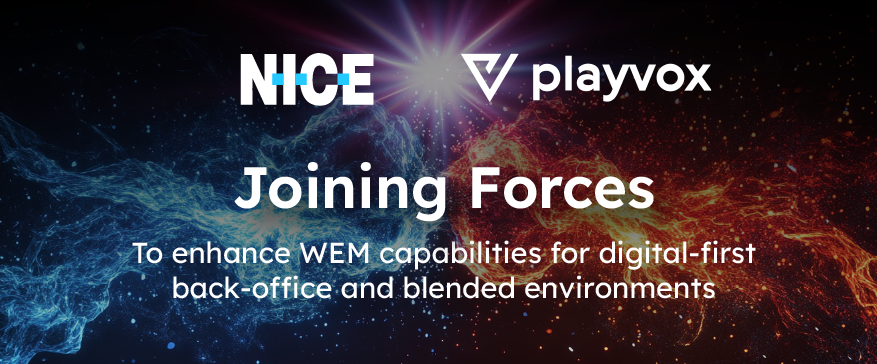Creating Personalized Customer Journeys with AI
Nearly 75 percent of consumers expect a personalized customer journey when interacting with companies, and even more get frustrated when they don’t receive it. From the ads in our Instagram feed to our Amazon product recommendations, personalization is everywhere—including today’s contact center. Approximately 70 percent of customers say that having an agent who knows who they are and their previous engagements with the company is essential.
That’s why delivering a personalized customer journey requires more than ensuring agents greet customers by name or plugging their names in the “to” field on a mass email. Additionally, personalized customer experiences are more than a single, customized engagement; they are a tapestry of deliberate, seamlessly woven-together interactions.
Effective personalization at scale is challenging, requiring solid data, AI-powered technology, and organizational commitment to delivering personalized customer experiences. However, the juice is worth the squeeze. According to McKinsey & Company research, customized customer journeys drive performance and better business outcomes, and “companies that grow faster drive 40 percent more of their revenue from personalization than their slower-growing counterparts.”
Let’s explore best practices for creating personalized customer journeys and how AI can be a game-changer in this process.
Importance of Personalization in Customer Service
Just in case the research mentioned above stats weren’t clear enough, let’s be more direct. Your customers:
- Want and expect you to deliver personalized experiences.
- Have a better, smoother, and more meaningful customer experience when personalization is involved.
- Feel understood and valued when you personalize their interactions.
- Are more likely to become a loyal customer to your brand if you provide a personalized customer journey.
From there, the equation is straightforward: increased customer loyalty drives improved customer retention and revenue—making personalization a win-win for your business and customers.
Challenges in Personalization
So, if personalization is good for everyone, why don’t all companies deliver personalized customer journeys? Because, like most digital initiatives, it’s easier said than done.
Research by Deloitte Digital reveals a gap between company intent and customer perception regarding personalization. Though brands report personalizing 61% of customer experiences, surveyed consumers only recognized that 43% of their interactions were personalized. This gap reveals that despite their best efforts, some challenges get in the way of delivering the personalization that matters to each individual customer.
Legacy Systems and Processes
In technology, as in life, you typically can’t teach an old dog new tricks. However, many customer service organizations try to dip their toe into the personalization pool using outdated systems that make effective personalization impossible. Here are some signs that your systems and processes might impede your personalization efforts:
- Your customer experience data is disorganized and siloed across multiple systems.
- Different teams use different systems to engage with customers across various channels.
- Your technology stack isn’t fully integrated, creating bottlenecks and data inconsistencies.
- Adopting new technologies, such as artificial intelligence (AI) and machine learning (ML), is technically challenging due to your platforms’ rigidity or lack of agility. This is especially true of legacy on-premises systems.
Though successful personalization initiatives require more than technology, ensuring your contact center has the right tools to realize your personalization goals is an important first consideration.
Privacy Concerns and Data Protection
The success of your personalization efforts hinges on your ability to retain, understand, and use your customer data to improve their experiences. However, collecting data opens the inevitable (and essential) door to data compliance and protection.
Data privacy compliance is complex and an ongoing challenge for most brands, especially those with a global footprint. Though European regulations like GDPR have set the standard, data protection is increasingly important across continents. 71% of countries now have data privacy legislation, with that number continuously increasing.
These regulations are critical in safeguarding customer privacy but also add a layer of complexity for leaders looking to personalize their customer journeys. To help mitigate these challenges, consider the following:
- Identify and understand the regulatory requirements applicable to your company.
- Consult with your data protection officer (DPO), compliance or legal teams, and even your Chief Technology Officer (CTO) before collecting types or pieces of customer data.
- Don’t collect data you don’t need or won’t use.
- Develop and maintain comprehensive documentation, processes, and ongoing training for all employees interacting with customers or customer data.
Balancing Personalization with Customer Preferences
Nobody likes a creep, and the same goes for personalization in business. Do customers want you to personalize their experiences? Yes. Do they want to feel like you’re creeping around like a crazy ex? NO!
Therein lies the challenge: Striking the delicate balance between too much and not enough personalization. Deloitte Digital recommends that companies consider the following questions:
- How personal is too personal?
- What is the line between helpfulness and intrusiveness?
- Where is the point of diminishing returns relative to implementation costs?
The answer will be unique to your industry, company, product, and customer base, so there’s no one-size-fits-all solution to this challenge. However, AI-powered digital analytics solutions enable companies to better understand their customer preferences and behaviors—helping reveal critical insights to answer these questions and strike the right balance.

Best Practices for Personalizing Customer Journeys
Though personalizing your customer experience can be challenging, leading companies provide everyday proof that it’s possible. Consider the following best practices as you design and implement your customer experience personalization strategy.
Understand Your Customer Journeys
Though this might seem obvious—“How do you personalize something you don’t understand?!”—it’s startlingly necessary to state. The contact center industry used to talk about the customer journey as a consistent path all customers followed. However, that all changed with digital transformation and many channel interaction types.
Today’s customer experience leaders understand that a customer’s journey typically doesn’t follow the same designated sequence every time. This new reality makes deeply understanding your customers’ behaviors and preferences more critical than ever to effectively predict their next step or anticipate an impending problem or need.
Segment your customers and identify the most common paths or interaction sequences based on their personas, products, demographics, and past behaviors. Then, you can use AI to help predict the right offer, message, or intervention to optimize their customer journey.
Also, remember that when we say customer journeys, we’re talking about the holistic customer experience—not their journey in one interaction. Therefore, it’s critical to consider not only customer service interactions handled by your contact center but all customer touchpoints with your brand, starting at awareness and acquisition through ongoing support and marketing.
Improve Cross-functional Alignment
Understanding and personalizing holistic customer journeys can sound daunting or impossible if the teams that directly influence your customer experience work in silos. Take this common scenario.
Let’s say your customer service help desk manages:
- Voice interactions
- SMS interactions
- Chat interactions
- 1:1 email interactions
- Other digital channels, such as WhatsApp
- Self-service channels, including managing your conversational IVR, chatbots, and knowledge management content
Additionally, your marketing team manages the following:
- Social channels, including inbound social messaging
- Web experiences, including banner messages alerting customers of updates and your online check-out process.
- Outbound via email, SMS, and other channels for all marketing campaign touchpoints, from acquisition through ongoing upsell, cross-sell, and retention initiatives
That’s a lot of touchpoints with one customer! Add to that the common complexity of each team using its own set of tools to do so. However, to the customer, all these touchpoints are from one brand, so consistency is key to maintaining trust and credibility.
With both teams driving personalization efforts, it’s easy to send uncoordinated or conflicting messages to customers. For example, let’s say:
- Your customer service team sends a personalized SMS message to customers to remind them of an overdue monthly payment.
- On that same day, your marketing team sends them a personalized cross-sell email promoting a new product.
- That customer chats with an agent about an issue with their bill (that’s why they haven’t paid yet) and mentions the new product promotion—but the agent doesn’t know about it.
- The outcome: A confused, slightly irritated customer.
Sending a cross-sell message when the customer’s account isn’t up to date can appear tone-deaf, while the agent’s lack of knowledge gives the customer the impression that your company doesn’t know what’s going on. Avoiding this scenario requires solid alignment, collaboration, and communication regarding your overall CX.
Breaking down these organizational silos requires a more coordinated effort between cross-functional leaders and organizational alignment on common goals for CX and marketing efforts. The following tactics can help:
- Unify your teams’ activities into common systems.
- Hold regular cross-functional meetings about upcoming and ongoing initiatives.
- Use AI-powered tools to streamline communication and workflows.
- Surface AI-powered insights during agent interactions to notify them of relevant marketing touchpoints the customer has been exposed to.
Meet Customers on Their Preferred Channels
Customer communication preferences have evolved significantly in recent years. A 2023 Salesforce study reveals that customers use as many as eight channels to contact companies, with digital channels such as email, mobile apps, chat, and online portals being among their favorites.
According to Deloitte Digital’s 2024 personalization research, the most successful brands are 25% more likely to personalize based on customer channel preferences than companies with low personalization maturity. They’re also 32% more likely to invest in omnichannel delivery.
So what does this mean for you? First, think about personalization in an omnichannel context, enabling agents and systems to have the right information at the right time across all customer channels. Secondly, your proactive, outbound personalization efforts should reach customers on their preferred channels.
If a customer prefers SMS, sending them an email about an impending outage will likely be ineffective. Conversely, sending them a personalized text message might feel intrusive and annoying if they prefer email over SMS.
AI can help you achieve both goals by helping you understand your customers’ behavioral preferences, using predictive analytics to anticipate their needs, and automating message delivery on their preferred channels.
Ensure Personalization Consistency Across Channels
Though we mentioned cross-channel consistency in the context of organizational alignment and customer channel preferences, it’s worth its own bullet point. Your customers use various channels daily, meaning they might chat with an agent via their phone in one minute, engage with a chatbot from their computer in the next, and read a marketing email from their tablet two hours later.
General consistency across channels is critical, but even more so when it comes to personalization. If you’re going to know your customers, know them everywhere, not just in one place they engage with you.
Empower Agents
Customer service agents can be your secret advantage when it comes to personalization. Despite the uptick in customer self-service and AI-powered digital engagement, customers still prefer human support for many scenarios.
Enabling agents with AI-powered capabilities can unleash their potential for personalization. Three increasingly important AI-powered use cases include:
- Interaction and customer history summarization: To personalize the customer experience, the agent needs to know the most relevant information about the customer in the context of this specific interaction—and scrolling through pages of customer history won’t work. AI can parse and summarize the customer’s data, popping only the information most relevant to help now.
- Next-best action prediction: AI-powered predictive analytics can identify and surface potential issues and opportunities to agents during an interaction. For example, upcoming account renewals, relevant content, personalized recommendations, upsell and cross-sell opportunities, service interruptions, etc.
- Task and workflow automation: Delivering a personalized experience requires agent attentiveness and focus—two things that can be hard to come by in the contact center. Using AI to automate and offload mundane agent tasks empowers them to focus more on the information and the customer at hand and better personalize their interaction.
Adopting these capabilities not only boosts personalization outcomes but also improves contact center efficiency and customer satisfaction.
Focus on Customer Value
No matter “what” or “where” you’re personalizing the customer journey, your “why” should be the same: To bring your customers value. Continuously ask yourself, “How will this personalization effort make my customer’s life better or easier?”
Doing so helps you filter your personalization efforts through a customer-focused lens rather than a business-focused one. So, whether anticipating a customer problem or uncovering a complementary purchase, your customers should be able to tangibly connect your personalization messages with their needs.
Uplevel Your Personalization with Playvox
Personalization is critical to delivering better customer journeys and meeting customer expectations, and companies that do it well have a clear competitive advantage over those that don’t. Amidst the mountain of contact center priorities, creating tailored experiences might feel more like a pipe dream than a potential reality. Luckily, you’re not on this journey alone.
Playvox partners with companies to power AI-infused customer experiences and bring out the best in employees so they can deliver for customers. From workforce and quality management to omnichannel routing, explore other vital ways AI is changing how contact centers do business in our new ebook, Transforming Customer Experience: The Impact Of AI On Contact Centers.







